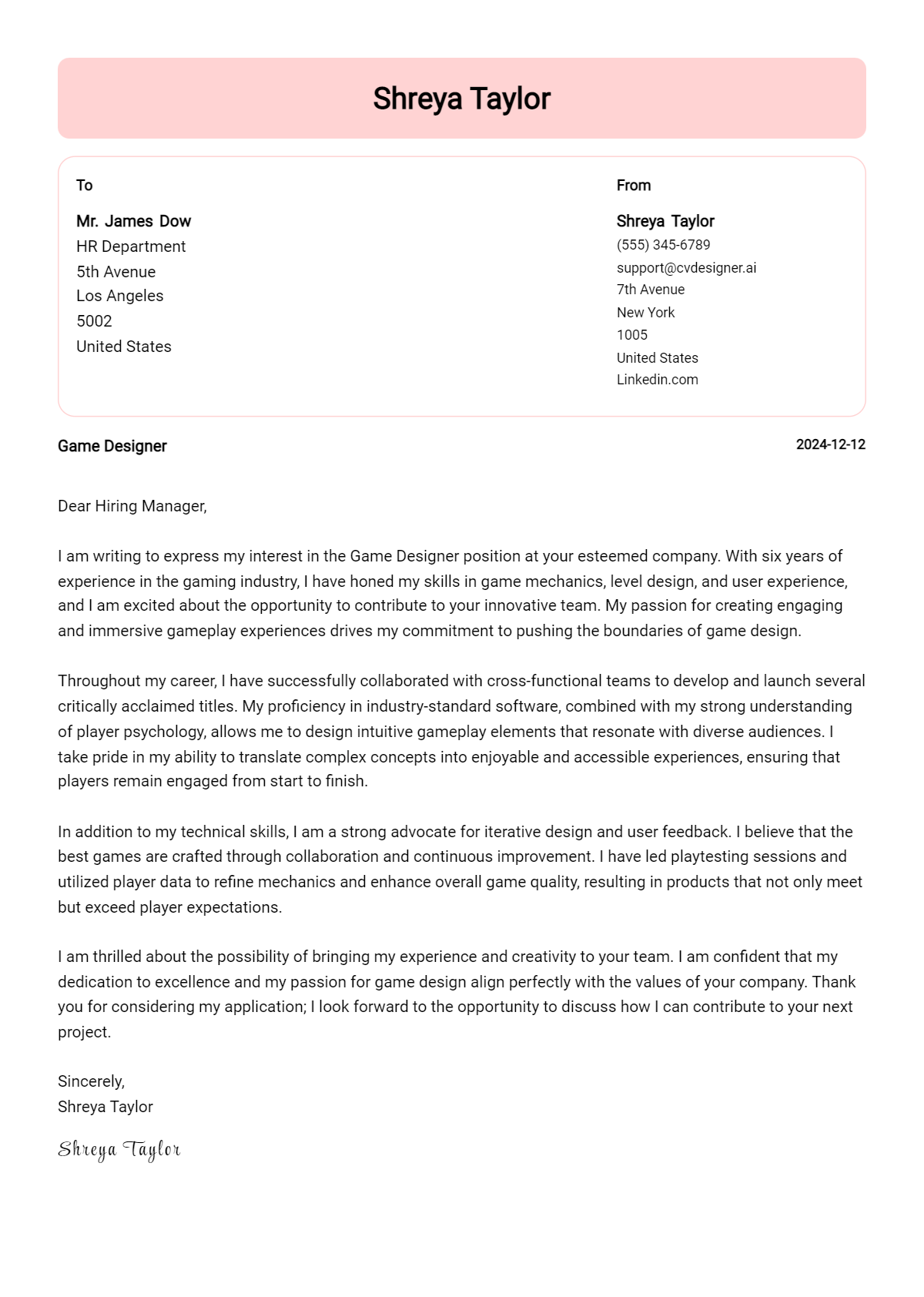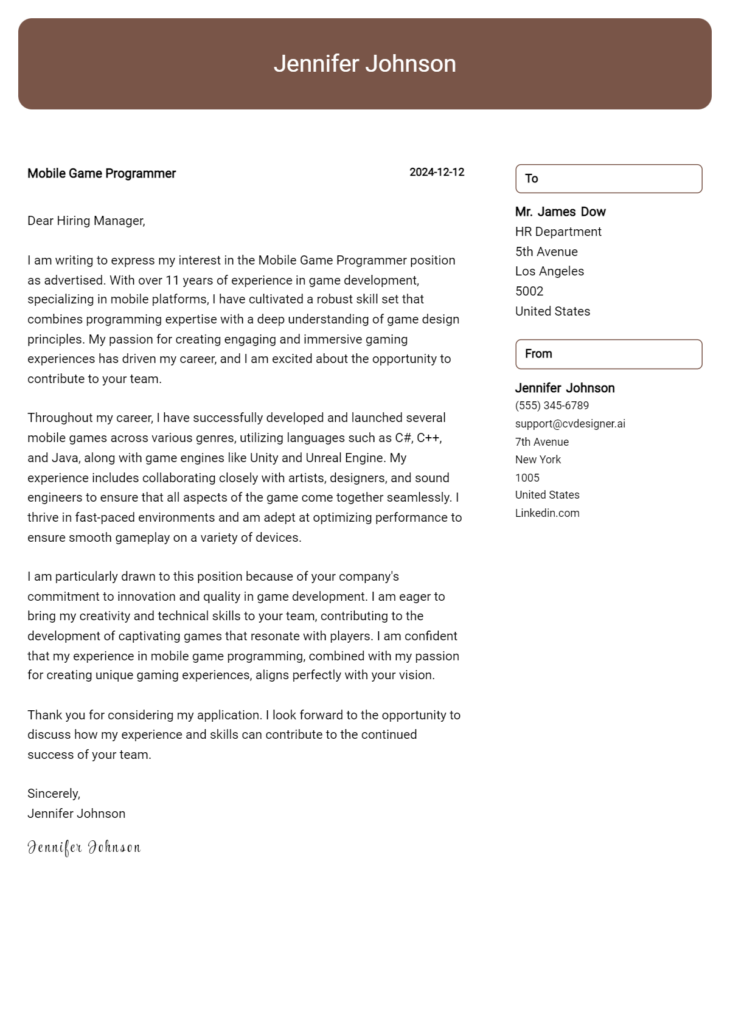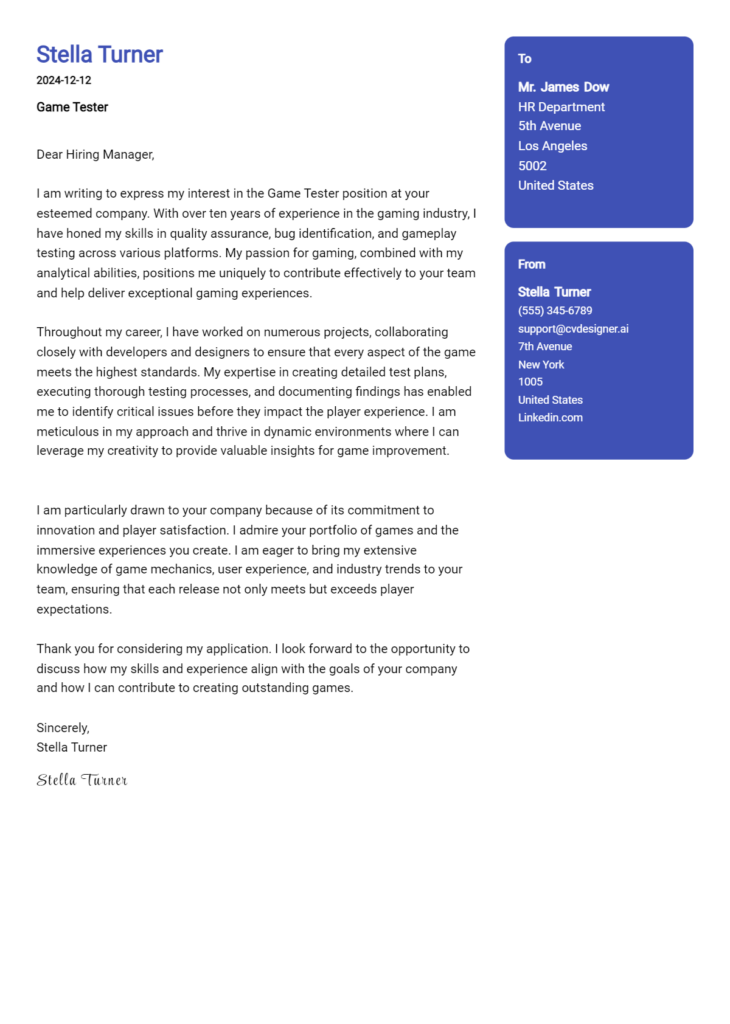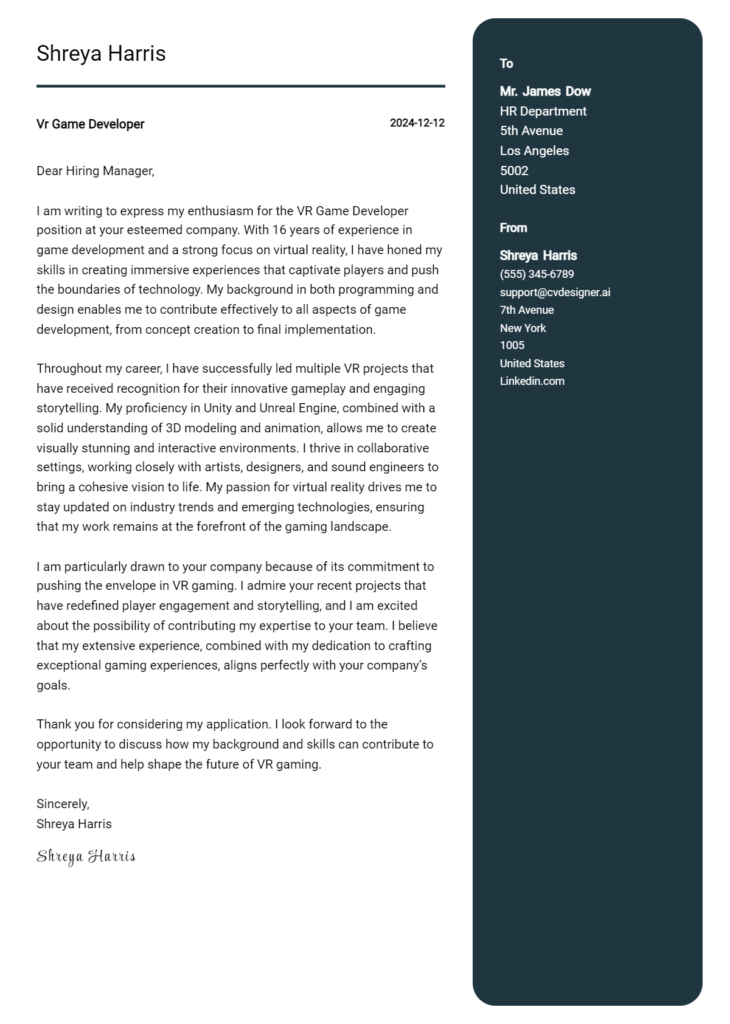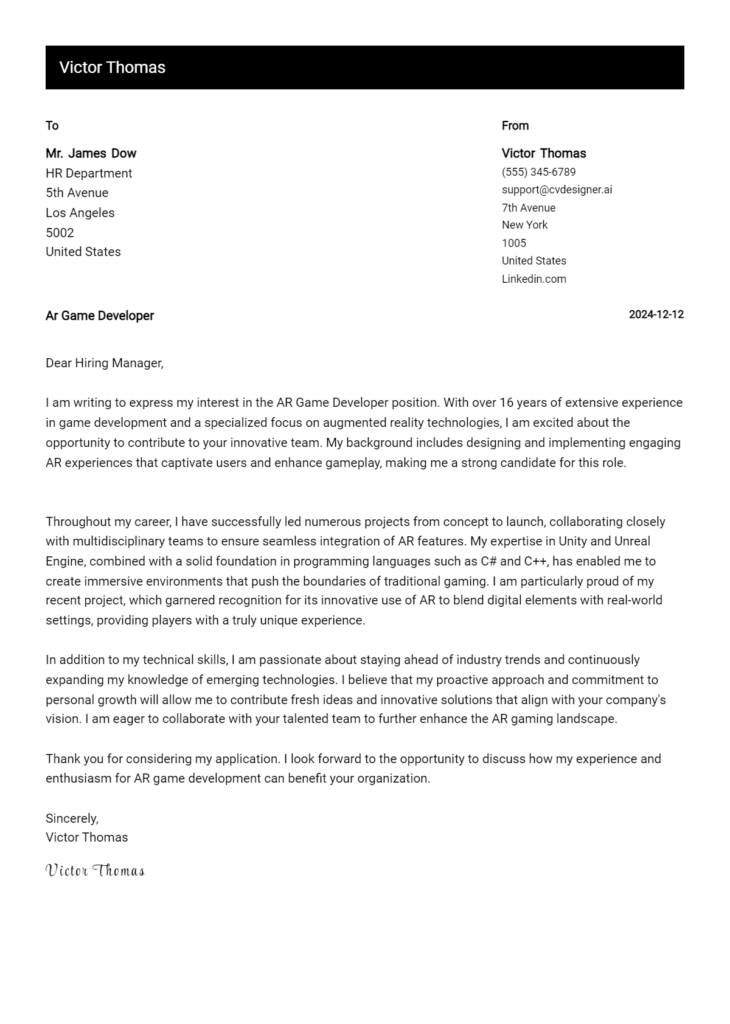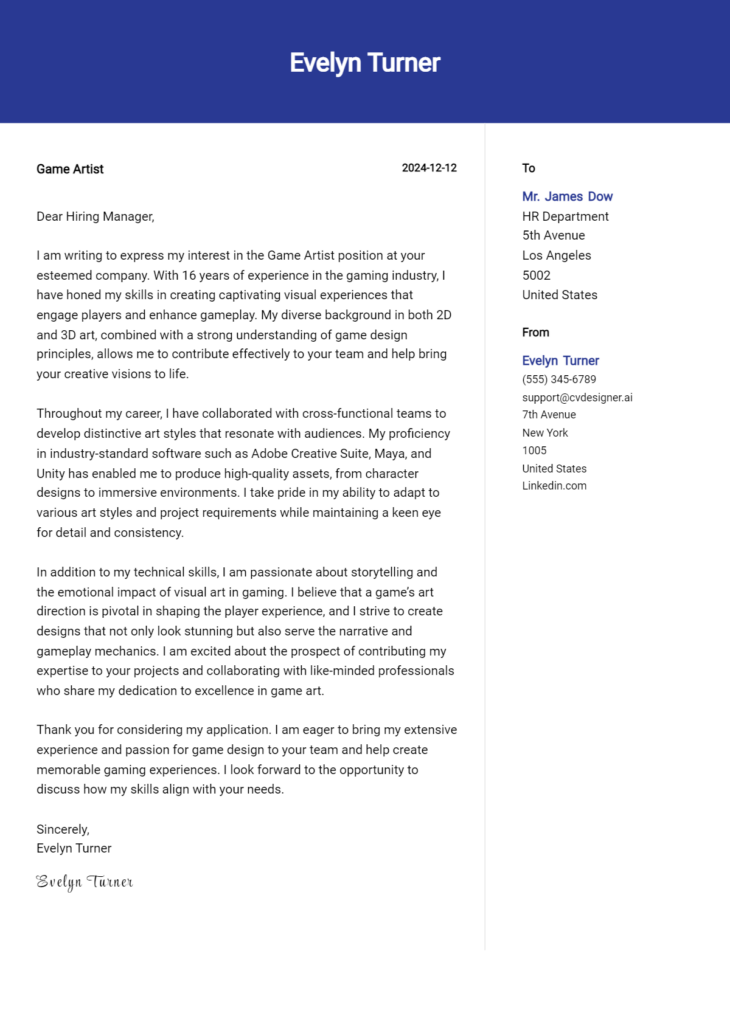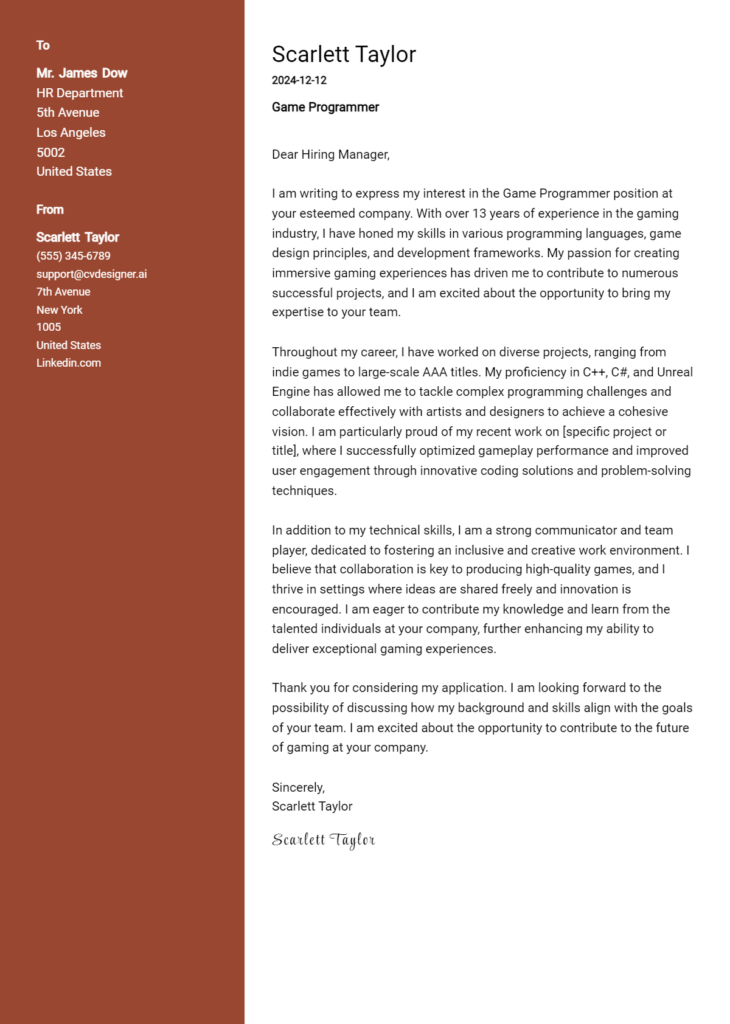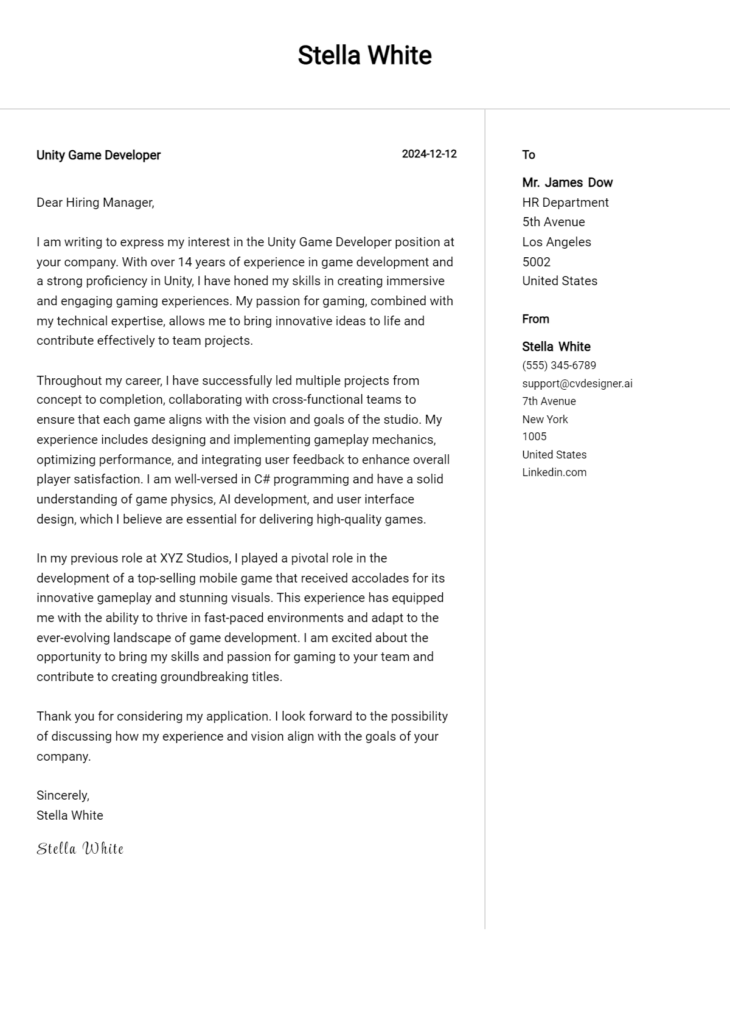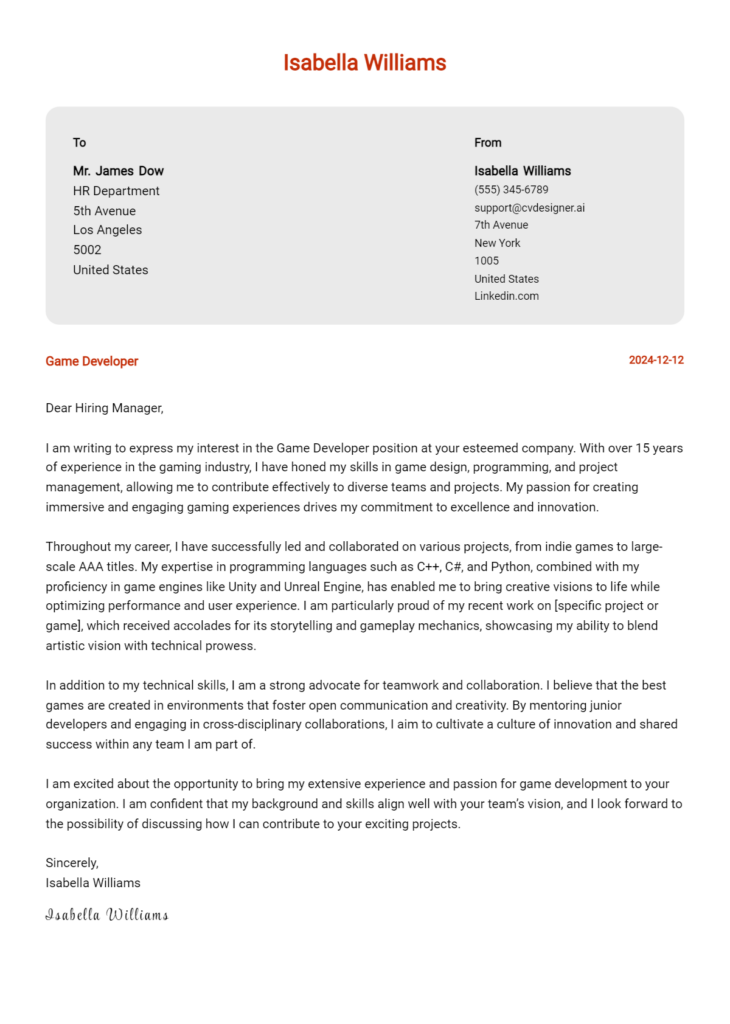Game Designer Cover Letter Examples
Explore additional Game Designer cover letter samples and guides and see what works for your level of experience or role.
How to Format a Game Designer Cover Letter?
Crafting an engaging cover letter is essential for a Game Designer, as it not only showcases your creative abilities but also reflects your understanding of game mechanics and user experience. A well-structured cover letter can captivate the hiring manager's imagination and demonstrate your passion for game design, which are critical aspects of this dynamic field. Just as gameplay should be immersive and intuitive, your cover letter should guide the reader through your qualifications and experiences seamlessly.
In this guide, we will delve into the key components of an effective cover letter, ensuring it aligns with the expectations of the gaming industry.
We'll focus on the essential elements of a professional cover letter, including:
- Cover Letter Header
- Cover Letter Greeting
- Cover Letter Introduction
- Cover Letter Body
- Cover Letter Closing
Each section is crucial for presenting your unique skills and enthusiasm for game design. Let’s explore how to make your Game Designer cover letter truly stand out.
The Importance of a Cover Letter Header for a Game Designer
The cover letter header is a crucial element of any professional correspondence, including for a Game Designer. It sets the tone for the entire document and provides essential information for the recipient. A well-structured header should include your contact information, the date of writing, and the recipient's details, ensuring clarity and professionalism. This not only helps the hiring manager to identify your application quickly but also reflects your attention to detail—an important skill in game design.
A strong header conveys professionalism and organization, while a weak one may give the impression of carelessness, potentially diminishing your chances of making a good first impression.
Strong Example
John Doe 123 Game St. Creative City, CA 12345 john.doe@email.com (555) 123-4567 October 1, 2023 Jane Smith Head of Recruitment Game Development Studios 456 Creative Ave. Innovative Town, CA 67890
Weak Example
John D. 10/1/23 To Whom It May Concern
The Importance of a Strong Cover Letter Greeting for Game Designers
The greeting of your cover letter is crucial in setting the tone for the rest of your application. It is the first impression the hiring manager will have of you, and it establishes a sense of professionalism and personalization. By directly addressing the hiring manager by name, you demonstrate not only your attention to detail but also your genuine interest in the position and the company. Avoiding generic greetings, such as "To Whom It May Concern," signals that you've done your research and are truly invested in the opportunity. If the recipient's name isn't readily available, take the time to look it up on the company's website or LinkedIn. This small effort can significantly impact how your application is perceived.
Strong Greeting Example
Dear Ms. Johnson,
Weak Greeting Example
To Whom It May Concern,
By choosing a strong greeting, you invite the hiring manager to engage with your letter, setting a positive tone for the rest of your application and increasing your chances of making a lasting impression.
The Importance of an Engaging Cover Letter Introduction for a Game Designer
A well-crafted cover letter introduction is crucial for a Game Designer as it serves as the first impression on the hiring manager. This opening paragraph should not only capture their attention but also express genuine interest in the role and briefly highlight the candidate's key skills or achievements. An engaging introduction sets the tone for the rest of the cover letter, making it essential to strike the right balance between enthusiasm and professionalism. Below are examples of both strong and weak cover letter introductions for a Game Designer position.
Strong Example
Dear [Hiring Manager's Name], As a passionate Game Designer with over five years of experience in creating immersive gaming experiences, I was thrilled to discover the opening at [Company Name]. My commitment to blending innovative storytelling with captivating gameplay has led to multiple award-winning titles, including [Specific Game Name]. I am excited about the opportunity to contribute my expertise in level design and player engagement to your talented team, pushing the boundaries of interactive entertainment together.
Weak Example
To Whom It May Concern, I am writing to apply for the Game Designer position. I have worked in the industry for a while and have some skills that might be useful for your company. I think I could help with designing games or something like that.
Cover Letter Body for Game Designer
The body of a cover letter for a Game Designer serves as a crucial platform for candidates to showcase their unique skills, relevant experiences, and the value they can bring to the company. This section allows applicants to highlight specific projects they have contributed to, detailing their roles and the impact of their work on the game's success. By emphasizing accomplishments such as successful game launches, innovative design solutions, or recognition received for their work, candidates can illustrate their capability and passion for game design. Effectively communicating these elements can help differentiate a candidate from others by demonstrating not just their qualifications, but also their dedication to the craft and understanding of the gaming industry.
Strong Example
Dear [Hiring Manager's Name], I am excited to apply for the Game Designer position at [Company Name]. With over five years of experience in the gaming industry, I have successfully led the design of three AAA titles, including the award-winning "Epic Quest" which garnered over 1 million downloads in its first month. My role as the lead designer involved creating immersive gameplay mechanics and collaborating closely with artists and programmers to ensure a cohesive vision. Additionally, my work on "Fantasy Realms" introduced innovative AI-driven NPC behavior that enhanced player experience, resulting in a 30% increase in user retention. I am eager to bring my creative problem-solving skills and passion for storytelling to [Company Name] and contribute to the development of engaging and memorable gaming experiences. Sincerely, [Your Name]
Weak Example
Dear [Hiring Manager's Name], I am writing to apply for the Game Designer job at [Company Name]. I have worked on some games and have some skills in design. I think I could help your team. I once made a small game for a project, and it was okay. I like playing games and want to make them. I believe I would be a good fit for your company. Best, [Your Name]
Importance of Cover Letter Closing for a Game Designer
The closing of a cover letter is crucial as it serves to encapsulate your qualifications, reiterate your enthusiasm for the game designer role, and prompt the hiring manager to take the next steps, such as reviewing your resume or scheduling an interview. A well-crafted closing can leave a lasting impression, showcasing your professionalism and eagerness to contribute to the team. Below are examples of strong and weak closing paragraphs:
Strong Example
Thank you for considering my application for the Game Designer position at [Company Name]. With my extensive experience in game mechanics and a passion for innovative storytelling, I am excited about the opportunity to contribute to your team. I believe my skills align perfectly with the goals of your projects. I look forward to the possibility of discussing my application further and am eager for the chance to bring my creative ideas to [Company Name]. Please feel free to review my attached resume, and I hope to hear from you soon to schedule an interview.
Weak Example
I hope you think about my application. I have some experience in game design, and I kind of like the idea of working at your company. Let me know if you want to talk more or something. Thanks, I guess.
Crafting an effective cover letter is crucial for game designers looking to stand out in a competitive field. This document serves not only as an introduction to your skills and experiences but also as a reflection of your passion for gaming and your commitment to continuous learning. To make a memorable impression, it’s essential to highlight your technical skills, problem-solving abilities, knowledge of the Software Development Life Cycle (SDLC), teamwork experience, and enthusiasm for innovation in game design. Below are five detailed tips to help you create a compelling cover letter.
Tips for Writing a Game Designer Cover Letter
Showcase Your Technical Skills
Clearly outline your technical proficiencies relevant to game design, such as programming languages (C#, C++, Python), game engines (Unity, Unreal Engine), and software tools (Blender, Photoshop). Use specific examples of projects where you applied these skills to achieve a successful outcome. This demonstrates not only your abilities but also your hands-on experience.Highlight Problem-Solving Abilities
Game design often involves overcoming complex challenges. Use your cover letter to describe instances where you identified and solved significant issues during the development process. This could include adjusting game mechanics based on player feedback or optimizing performance to enhance user experience. Emphasizing your analytical skills will show potential employers your capability to navigate obstacles creatively.Demonstrate SDLC Knowledge
Knowledge of the Software Development Life Cycle is crucial for a game designer. Discuss your familiarity with various stages, from requirements gathering to testing and deployment. Share experiences where you collaborated with other departments, such as developers and QA testers, to ensure the smooth progression of a project. This illustrates your understanding of the broader context of game development.Emphasize Teamwork and Collaboration
Game design is rarely a solo endeavor; it requires effective collaboration with a diverse team. Provide examples of how you have worked within a team setting, whether through brainstorming sessions, design critiques, or development sprints. Highlighting your interpersonal skills and ability to communicate effectively will reassure employers of your fit within their team.Express a Passion for Continuous Learning
The gaming industry is constantly evolving, making it essential for designers to stay updated with the latest trends and technologies. Mention any relevant courses, workshops, or personal projects that demonstrate your commitment to professional growth. This not only shows your dedication to your craft but also your adaptability in a fast-paced environment.
For more resources, consider exploring cover letter templates to help structure your letter, or use a cover letter builder to create a polished and professional document. With these tips, you're well on your way to crafting an engaging cover letter that captures the attention of hiring managers in the gaming industry.
Common Mistakes to Avoid in a Game Designer Cover Letter
Crafting a compelling cover letter is essential for standing out in the competitive field of game design. Avoiding common mistakes can significantly enhance your chances of making a positive impression on potential employers. Here are some frequent pitfalls to watch out for when writing your cover letter:
Generic Content: Tailoring your cover letter to the specific job and company is crucial. Avoid using a one-size-fits-all approach. Research the company and reflect its values and goals in your letter.
Ignoring the Job Description: Failing to address the specific skills and experiences mentioned in the job listing can undermine your application. Highlight how your background aligns with the requirements outlined in the cover letter examples.
Lack of Passion: Game design is a creative field, and employers want to see your enthusiasm. Avoid a dry, overly formal tone; instead, let your passion for gaming and design shine through.
Poor Formatting: An unprofessional format can detract from your content. Refer to the cover letter format guidelines to ensure your letter is visually appealing and easy to read.
Neglecting to Proofread: Spelling and grammatical errors can create a negative impression. Always proofread your letter multiple times and consider asking someone else to review it as well.
Overloading with Jargon: While industry-specific language can demonstrate expertise, too much jargon can alienate readers. Aim for a balance that showcases your knowledge without overwhelming the reader.
Skipping a Call to Action: Failing to include a strong closing statement can leave your letter feeling incomplete. Encourage the employer to reach out for further discussion about your fit for the role.
By steering clear of these common mistakes, you can create a cover letter that effectively showcases your skills and enthusiasm, setting you on the path to success in your game design career.
Cover Letter FAQs for Game Designer
What should I include in my cover letter as a Game Designer?
In your cover letter, include your passion for gaming and design, highlighting your relevant skills and experiences. Start with a strong opening that captures attention, then briefly summarize your design philosophy and style. Mention specific projects you've worked on, outlining your role and the tools or software you used. Showcase any unique accomplishments, such as awards or recognition in the industry. Finally, express your enthusiasm for the company and how your vision aligns with their goals. Tailoring your cover letter to each job will show your genuine interest and commitment.
How can I demonstrate my skills in my cover letter?
To demonstrate your skills in your cover letter, provide concrete examples from your past work. Instead of simply listing skills, discuss how you've applied them in real projects. For instance, if you excel in level design, describe a particular level you created, explaining the design choices you made and the impact on gameplay. Use metrics where possible, such as increased player engagement or positive feedback received. Additionally, mention any software proficiency, such as Unity or Unreal Engine, and how it contributed to your projects’ success. This approach will effectively showcase your capabilities and experience.
Should I include any personal projects in my cover letter?
Yes, including personal projects in your cover letter can significantly enhance your application. Personal projects demonstrate your passion for game design and your initiative to create, even outside of professional settings. Discuss any independent games or mods you've developed, highlighting the design process, challenges faced, and your solutions. This not only showcases your skills but also your creativity and dedication to the craft. Make sure to link to any playable versions or portfolios to give potential employers a firsthand look at your work. Personal projects can set you apart from other candidates who may only have formal experience.
How long should my cover letter be?
Your cover letter should ideally be one page long, consisting of 3-4 paragraphs. This length allows you to convey your qualifications without overwhelming the reader. Start with a strong introduction that grabs attention, followed by body paragraphs that detail your relevant experience, skills, and fit for the position. Conclude with a compelling closing statement that reiterates your enthusiasm for the role and the company. Keeping your cover letter concise ensures clarity and emphasizes your most important qualifications, making it easier for hiring managers to digest your information quickly.
Build your Cover Letter in minutes
Use an AI-powered cover letter builder and have your letter done in 5 minutes. Just select your template and our software will guide you through the process.

